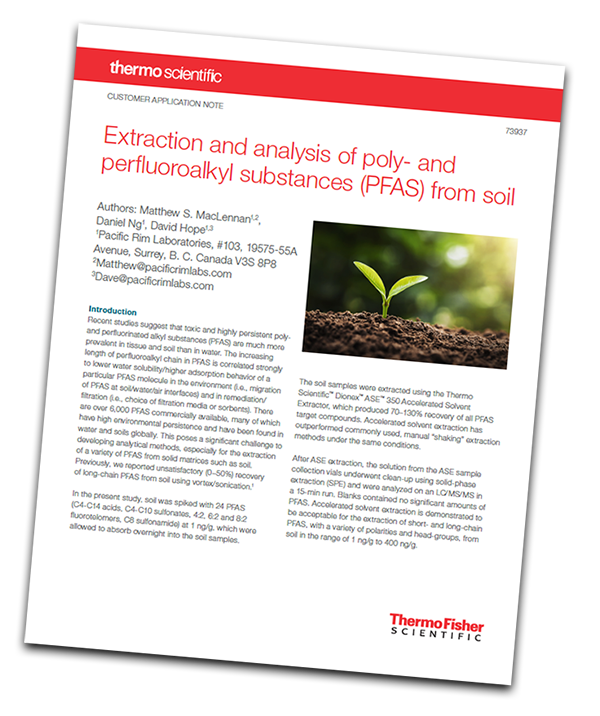This application note demonstrates how accelerated solvent extraction can extract a variety of PFAS from soil including acids, sulfonates, fluorotelomer sulfonates, and sulfonamide compounds.
 Introduction
Introduction
Recent studies suggest that toxic and highly persistent poly- and perfluorinated alkyl substances (PFAS) are much more prevalent in tissue and soil than in water. The increasing length of perfluoroalkyl chain in PFAS is correlated strongly to lower water solubility/higher adsorption behavior of a particular PFAS molecule in the environment (i.e., migration of PFAS at soil/water/air interfaces) and in remediation/filtration (i.e., choice of filtration media or sorbents). There are over 6,000 PFAS commercially available, many of which have high environmental persistence and have been found in water and soils globally. This poses a significant challenge to developing analytical methods, especially for the extraction of a variety of PFAS from solid matrices such as soil. Previously, we reported unsatisfactory (0–50%) recovery of long-chain PFAS from soil using vortex/sonication.
In the present study, soil was spiked with 24 PFAS (C4-C14 acids, C4-C10 sulfonates, 4:2, 6:2 and 8:2 fluorotelomers, C8 sulfonamide) at 1 ng/g, which were allowed to absorb overnight into the soil samples.
Experimental
Full details of the experimental conditions can be found by downloading the application note.
Conclusion
Accelerated solvent extraction can extract a variety of PFAS from soil including acids, sulfonates, fluorotelomer sulfonates, and sulfonamide compounds. Although the Dionex ASE 350 system utilized in this method contained Teflon lines, the lines had been used under a variety of different solvent conditions, effectively reducing the PFAS background contamination to a minimum. Isotopic dilution quantification was utilized for most analytes and demonstrated linearity for all PFAS studied in soil over the range of 1 ppb to 400 ppb. PFTrDA linearity is biased low which is partially due to PFTrDA being quantified via the internal standard method against 13C2-PFTeDA and not an isotopically labeled analog of PFTrDA, but more strongly due to the effects of naturally abundant 13C2-PFTeDA (from the native spiked levels) artificially increasing the recoveries of internal standard, thus underestimating the native levels of PFTrDA.
Previously experienced difficulties recovering long-chain PFAS from soil using sonication/vortex methods were surmounted by using ASE, demonstrating that the absence of long-chain PFAS is a true absence and not simply low recovery. The approach described here was applied to a soil sample and it was found to contain between 1 and 50 ng/g of several PFAS. Accelerated solvent extraction is an acceptable method for extracting a wide selection of PFAS, from 4-carbon to 14-carbon fluoroalkyl chain lengths and five different polar head-groups, from soil over a wide range of concentrations. Accelerated solvent extraction shows high potential for effective extraction of the growing list of PFAS from solid samples.
